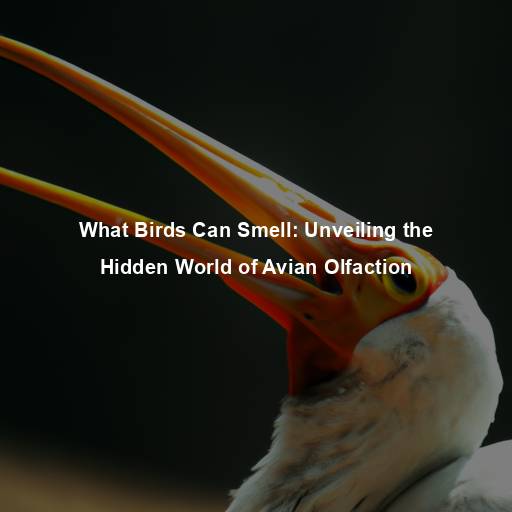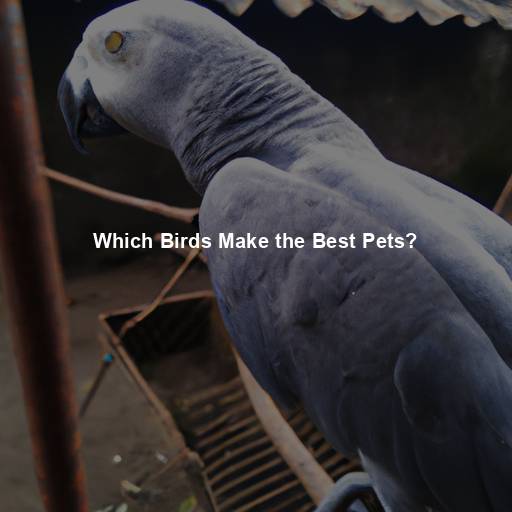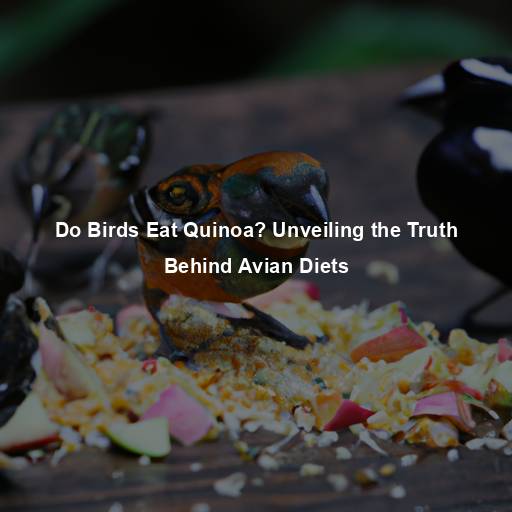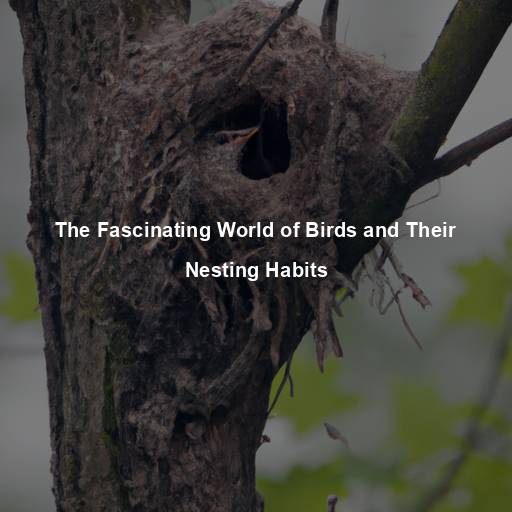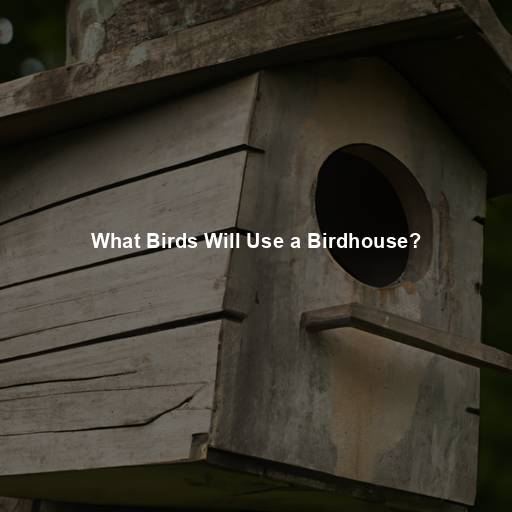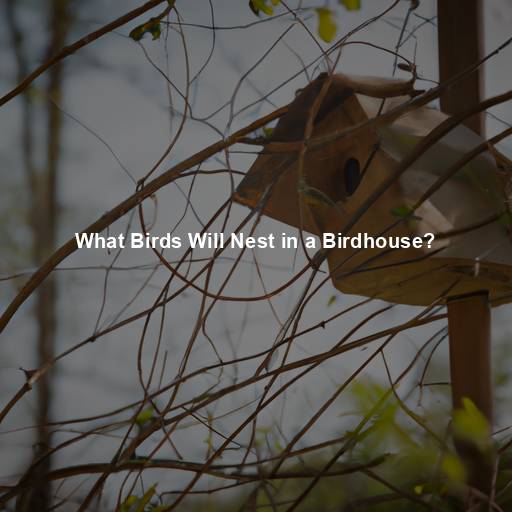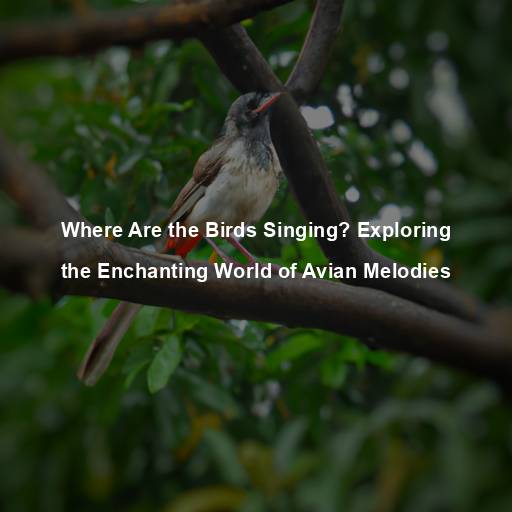What Birds Can Smell: Unveiling the Hidden World of Avian Olfaction
Last Updated on July 30, 2023 by Evan
Contents [hide]
- 1 Unraveling the Mystery of Avian Olfaction
- 1.1 Challenging the Myth: Birds and Their Olfactory Abilities
- 1.2 The Anatomical Marvel: Bird Olfactory System
- 1.3 Birds of a Feather: Diverse Olfactory Adaptations
- 1.4 Birds and the Sense of Smell: A Multi-Faceted Relationship
- 1.5 The Olfactory Enigma: Unanswered Questions
- 1.6 Interactions Between Birds and their Surroundings
- 1.7 The Evolutionary Puzzle: Origins and Adaptations
- 1.8 The Future of Avian Olfactory Research
- 2 Unveiling the Chemical Symphony: The Language of Avian Olfaction
- 3 FAQs: What Birds Can Smell
- 3.1 Can birds actually smell?
- 3.2 Which bird species have a well-developed sense of smell?
- 3.3 How do birds use their sense of smell?
- 3.4 Can birds detect scents in the same way humans do?
- 3.5 What other senses do birds use to find food?
- 3.6 Are there any bird species with no sense of smell?
- 3.7 Can birds smell food sources that are far away?
- 3.8 Can pet birds detect scents in the home?
- 3.9 Can birds smell dangerous situations or predators?
- 3.10 How has the sense of smell evolved in birds?
Unraveling the Mystery of Avian Olfaction
Birds have always fascinated us with their vibrant plumage, melodious songs, and graceful flight. But there’s an aspect of avian life that often goes unnoticed – their sense of smell. While it is widely believed that birds have a limited sense of smell compared to mammals, recent research has unveiled a whole new world of avian olfaction. In this captivating journey, we will delve into the hidden depths of bird noses and explore the marvelous scentscape that birds inhabit.
Challenging the Myth: Birds and Their Olfactory Abilities
For years, it was commonly believed that birds had a poor sense of smell, primarily due to the relatively smaller olfactory bulb in their brains compared to mammals. However, this notion has been debunked in recent times with groundbreaking studies showcasing the remarkable olfactory abilities of our feathered friends. Birds not only possess the necessary olfactory hardware but also exhibit an astonishing range of olfactory behaviors and adaptations.
The Anatomical Marvel: Bird Olfactory System
Delving into the realm of avian olfaction unveils a captivating landscape of perplexing intricacies. Unlike their mammalian counterparts, birds navigate the olfactory landscape with nuanced adaptations. The absence of a prominent olfactory cortex is compensated by the enigmatic presence of the “nucleus taeniae,” a structure that assumes a pivotal role in their olfactory journey. By embracing this atypical arrangement, birds unlock a trove of olfactory potentials that redefine our understanding of their sensory faculties.
Birds of a Feather: Diverse Olfactory Adaptations
Just like the incredible diversity seen in bird species worldwide, their olfactory adaptations vary significantly. Some birds rely heavily on olfaction for survival, while others utilize it for more specific purposes. Let’s take a closer look at some fascinating examples of avian olfactory adaptations:
Discover the intriguing world of vultures, those winged scavengers that roam the skies in search of their next meal. Feast your eyes on captivating photographs and delve into the mysterious lives of these enigmatic creatures. Unravel the paradoxical relationship between vultures and their environment, as they navigate the fine line between life and death. Prepare to be astounded by the untamed beauty and unexpected role played by these misunderstood beings in our natural world.
The humble vultures, with their extraordinary olfactory talents, are an invaluable asset to the ecosystem. With a nose for decay, these impressive birds have the uncanny ability to detect rotting remains over vast distances. Their impeccable sense of smell is not just a natural gift but a vital tool in the cutthroat realm of scavenging, ensuring their ongoing existence in a world teeming with competition.
Venturing into the realm of avian navigation, researchers have unravelled the enigma surrounding albatrosses and their uncanny ability to locate a delectable fishy feast. With heightened curiosity, scientists have explored the intricate olfactory mechanisms of these majestic seabirds, uncovering a world of scent detection beyond human comprehension. Through a captivating symphony of adaptation and precision, albatrosses navigate vast oceanic distances with an unparalleled burst of instinct, leaving both experts and enthusiasts perplexed by their extraordinary feats. Dive into the captivating saga of these feathered voyagers and immerse yourself in the perplexing allure of their olfactory prowess.
The world of albatrosses never ceases to amaze, as these magnificent seabirds possess an incredible olfactory adaptation that leaves us in awe. Their keen sense of smell allows them to detect the subtle scent of dimethyl sulfide, a compound released by minuscule marine organisms when they indulge in a feast of algae. It is this extraordinary skill that guides albatrosses towards regions teeming with plentiful fish, serving as a vital tool in their tireless pursuit of sustenance. Prepare to be perplexed by the astonishing abilities of these majestic creatures of the open ocean.
Discover the captivating world of penguins as they gracefully navigate the treacherous icy waters. These remarkable creatures showcase their natural agility and adaptability in the face of harsh conditions, leaving us in awe of their mesmerizing skills. Join us as we delve into the complexities of their underwater journeys, shedding light on the secrets that lie beneath the surface. Immerse yourself in the captivating beauty and enchanting mystery of the penguin’s aquatic domain.
Did you know that behind those cute waddles, penguins possess an unexpected and impressive ability? As unlikely as it may seem, these flightless birds possess a sharp sense of smell that they use to locate their next meal in the frigid and sometimes murky depths of the ocean. It’s fascinating how their olfactory powers play a crucial role in their hunting endeavors, allowing them to find fish and krill amidst the vast expanse of the sea.
Birds and the Sense of Smell: A Multi-Faceted Relationship
While some bird species rely heavily on olfaction, it is important to note that not all birds have the same olfactory prowess. The level of olfactory ability varies across species, even within the same family or order. Factors such as diet, habitat, and ecological niche influence the extent to which birds rely on their sense of smell.
- Diurnal Raptors: Eyes in the Skies
In the realm of avian predators, diurnal raptors reign supreme with their awe-inspiring visual acumen. These majestic creatures, ranging from regal hawks to soaring eagles, are renowned for their unparalleled ability to scan their surroundings with remarkable precision. Even though their sense of smell is not to be underestimated, it pales in comparison to the astonishing power of their sight. This extraordinary gift of vision serves as their ultimate weapon of choice when it comes to the art of hunting.
Experience the enigmatic allure of Procellariiformes, a captivating scent that captures the essence of the sea. Bursting with intrigue and perplexity, this fragrance takes you on a sensory journey to the vast oceans, where the mysterious birds of the Procellariiformes family call home. Immerse yourself in the exhilarating notes of briny waves, salt-kissed air, and the untamed beauty of seabirds soaring through the stormy skies. Unleash your inner wanderer and embrace the intoxicating mystique of Procellariiformes, a scent that will leave you longing for the untamed depths of the ocean.
Procellariiformes, a group of seabirds including petrels and shearwaters, have a strong connection to the sea. These birds have evolved to be excellent navigators, using a combination of visual cues and their sense of smell. The ability to detect specific odors helps them locate productive feeding areas amidst the vastness of the ocean.
The Olfactory Enigma: Unanswered Questions
Despite the progress made in unraveling the mysteries of avian olfaction, there are still many unanswered questions that pique the curiosity of researchers. Some of the lingering enigmas include:
Unraveling the enigmatic world of olfactory variation among our feathered friends, we delve into the perplexing realm of genetics. With a quest to uncover the secrets behind enhanced olfactory abilities in different bird species, we ponder the conundrum of whether there exists a distinct gene or cluster of genes responsible for their heightened sniffing prowess. Prepare to embark on a fascinating journey through the maze of avian genetics and the mysteries that lie within their aromatic adaptations.
2. The Influence of Habitat on Olfactory Development: How does the environment, including the availability of certain odors, shape the olfactory capabilities of birds? Are there specific adaptations observed in birds living in different habitats?
Bird communication has long fascinated scientists, who have extensively studied the fascinating world of avian vocalizations and visual displays. While these traditional modes of communication undoubtedly play a crucial role in their social interactions, a lingering question remains: what about olfaction? The perplexing role of olfactory signals in bird communication is a subject that continues to elude researchers, leaving them craving for more answers. As they diligently unravel this mysterious aspect of avian communication, a deeper understanding of the intricate language of birds awaits discovery.
Interactions Between Birds and their Surroundings
Birds perceive the world through a symphony of senses, and olfaction is just one piece of the puzzle. To fully appreciate the role of smell in a bird’s life, we must understand how it intertwines with other sensory modalities and influences their behavior and interactions with the environment.
Visual-Olfactory Integration
Birds, those majestic creatures that grace our skies, have long intrigued scientists and bird enthusiasts alike with their remarkable abilities. Among their many talents, their adeptness at combining the powers of both sight and smell is a subject of great wonder. Recent studies have revealed that certain species, like the renowned pigeons, are masterful navigators who rely on a harmonious blend of visual and olfactory cues. By utilizing this intricate integration, our feathered friends are able to create a vivid mental map of their surroundings, enabling them to make calculated choices regarding food, mates, and their path in the vast expanse above.
Olfaction and Feeding Behaviors
The sense of smell plays a crucial role in a bird’s feeding behaviors, particularly for species that rely on locating hidden or cryptic food sources. Many birds exhibit a specialized feeding technique known as “olfactory gleaning,” where they use their sense of smell to detect and locate prey items hidden beneath the surface of the ground or water. This behavior has been observed in various bird families, including ibises, herons, and shorebirds.
The Evolutionary Puzzle: Origins and Adaptations
The evolutionary origins of avian olfaction have long puzzled scientists. While it is clear that birds possess olfactory capabilities, the question remains: how did these adaptations arise?
Revisiting Ancestral Traits
Throughout evolution, there is a fascinating connection between birds and reptiles, as they both share a common ancestor. Surprisingly, while mammals may have left behind their reliance on scent, reptiles have maintained a keen sense of smell which plays a crucial role in their survival. Now, intriguingly, some scientists propose that birds, with their beaks and feathers, may have inherited a hint of this olfactory prowess from their reptilian heritage, but its role and influence have undoubtedly undergone captivating transformations over time.
The Influence of Ecological Niche
The role of ecological niche in shaping avian olfactory adaptations cannot be overstated. Birds that inhabit environments rich in olfactory cues, such as forests or marshlands, may have stronger olfactory capabilities compared to species in more visually dominated habitats. By adapting to their specific ecological niche, birds can maximize their chances of survival and reproductive success by utilizing the available sensory information effectively.
The Future of Avian Olfactory Research
The world of avian olfaction is undergoing a captivating evolution, as scientists delve deeper into the intricate complexities of bird noses. With each passing day, thrilling prospects for unraveling the enigmatic secrets held within the aromatic world of avian species reveal themselves. As our understanding grows, new avenues of research emerge, igniting a sense of wonder and anticipation for what lies ahead in the vibrant realm of bird olfaction.
Advancements in Genetic Studies
Unlocking the mysteries of avian olfaction has taken a giant leap forward with the advent of cutting-edge genetic research techniques. Scientists are now delving into the intricate world of bird genomes, comparing them across different species to pinpoint the elusive genes that govern olfactory abilities. By unraveling these genetic codes, a clearer understanding of how avian olfaction has evolved and the key factors influencing its variation can be revealed, paving the way for groundbreaking discoveries in this enigmatic field.
Behavioral Studies and Field Observations
The fascinating world of avian olfaction is a perplexing and ever-evolving subject, captivating researchers and observers alike. Through meticulous field observations and behavioral studies, a deeper understanding of the intricate ways in which birds utilize their sense of smell in their natural habitats begins to emerge. Bursting with curiosity and armed with a hunger for knowledge, scientists diligently document the olfactory behaviors of our feathered friends, unravelling the mysteries of when and why birds turn to this enigmatic sense. In doing so, they shed light on the intricate interplay between avian olfaction and the delicate balance of life in our bird-filled ecosystems.
Unveiling the Chemical Symphony: The Language of Avian Olfaction
The Olfactory Landscape: A Symphony of Scents
Welcome to the mesmeric realm of avian sensory perception, where the symphony of scents weaves a perplexing tapestry. In this aromatic landscape, birds effortlessly decipher a multitude of olfactory cues, forging a unique language of communication through smell. Join us on an enlightening journey as we unravel the mysteries of avian olfaction and unveil the intricate fragrant pathways that shape their fascinating world.
Chemical Signals in Bird Communication
In the captivating world of avian communication, it’s not just about chirps and dances. Birds have their own secret language, one that encompasses not only vocalizations and visual displays but also the mysterious realm of olfactory signals. Yes, you read that right – smells! These fragrant messages hold crucial significance, especially for bird species that call dense vegetation or dimly lit environments their home.
Pheromones: The Silent Communicators
Have you ever wondered how birds communicate with each other without making a sound? Well, it turns out that they have a secret weapon – pheromones! These mysterious chemical substances, secreted by birds, have the power to trigger specific behaviors and even physiological responses in their fellow feathered friends. From conveying important information about things like reproductive status to defining territorial boundaries and social hierarchies, pheromones play a crucial role in the intricate world of avian communication.
Ecological Insights: The Smell of Habitats
When it comes to the magnificent world of birds, there’s more to their connection with their surroundings than meets the eye. It turns out that their sense of smell, yes, you heard it right, their olfactory powers, actually have a significant impact on how they navigate their habitats. From identifying delicious morsels of food to detecting lurking dangers and even finding the perfect spot to build their nests, these feathered beings possess a sniffer sharper than you might have imagined. Discover the captivating interplay between birds and their keen sense of smell, as they unlock the secrets of their environment.
Food Odors: A Gastronomic Guide
Nature’s aromatic landscape acts as a tantalizing maze for birds, beckoning them to embark on a sensory voyage in search of sustenance. Guided by the alluring fragrances emanating from fruit-laden trees, blooming flowers, or the pungent essence of decaying matter, these feathered adventurers navigate through a world infused with perplexing scents. From the seductive aroma of ripened fruits to the alluring nectar embraced by blossoms, or even the musky allure of carrion that captivates scavengers, avian gastronomes rely on their olfactory prowess to uncover copious culinary treasures.
Nest Site Selection: Scented Sanctuaries
Birds often rely on olfactory cues to select suitable nesting sites. Some species, such as woodpeckers, excavate nest cavities in trees that emit specific odors indicating the presence of suitable wood quality and potential insect prey. By using their olfactory senses, birds ensure that their nests provide a safe and resource-rich environment for raising their offspring.
The Human Connection: Birds and the Scented World
Birds, with their intricate sense of smell, possess a fragrant realm that has intriguing implications for us humans. By delving into their aromatic encounters, we not only deepen our connection with nature, but also unlock uncharted territories for research and preservation endeavors. Embracing the enigmatic olfactory experiences of these winged wonders can truly enrich our lives.
Birdwatching by Scent
Birdwatching is often associated with visual and auditory observations, but incorporating scent into the experience can add a new dimension to our encounters with birds. By paying attention to the scents of the environment, we can gain a deeper understanding of the habitats birds inhabit and the interconnectedness of their lives with ours.
Conservation Implications
The intriguing world of avian olfaction holds valuable keys for conservation endeavors. Delving into the realm of avian scents could prove instrumental in guiding habitat restoration initiatives, as it unveils the precise fragrances that allure birds to specific habitats, resulting in the sustenance and growth of their populations. Moreover, by studying mankind’s scents, like pollutants and chemical contaminants, we may uncover ways to safeguard both avian olfactory systems and the well-being of our delicate ecosystems.
The Ongoing Olfactory Odyssey
Venturing into the realm of avian olfaction is an ever-evolving expedition, brimming with uncharted terrain and enigmatic riddles waiting to be solved. With each stride we take to unravel the enigma of avian olfaction, we unveil intricate layers of understanding, unveiling a multicolored tapestry of sensory wonders that define the avian realm. The melodic dance of scents, the cryptic language of communication, and the ecological marvels that avian olfaction unravels all interweave with the intricate symphony of life where birds play their magical role. So, let us embark upon this aromatic odyssey, with a thirst for knowledge, prepared to decode the captivating olfactory tales of our feathered friends.
Stay tuned for more enthralling revelations about the captivating world of avian olfaction!
FAQs: What Birds Can Smell
Can birds actually smell?
Without a doubt, avian creatures possess an intriguing sense of smell. Intricacies abound and the degree of olfactory prowess varies across species, yet it remains undeniable that many birds possess the essential receptors needed to navigate the world of scent. However, it must be noted that compared to their mammalian counterparts, the olfactory capabilities of our feathered friends tend to be less pronounced. Such a perplexing world of aromas they inhabit!
Which bird species have a well-developed sense of smell?
Some bird species have a particularly well-developed sense of smell. Vultures, for instance, are famous for their exceptional olfactory abilities, which allow them to locate carrion from great distances. Procellariiform seabirds, such as albatrosses and petrels, also possess a keen sense of smell to help them find food in the vast oceans.
How do birds use their sense of smell?
Birds use their sense of smell for various purposes. One important function is to locate food. Certain species, like Kiwis, use their olfactory abilities to find earthworms and other invertebrates hidden beneath the soil. Additionally, some birds rely on their sense of smell to identify and select suitable mates during the breeding season.
Can birds detect scents in the same way humans do?
It’s a fascinating exploration into the aromatic realm where birds and humans take separate paths. Unlike us humans, who possess a highly sophisticated olfactory system boasting a wide array of olfactory receptor genes, our feathered friends seem to have a more streamlined scent perception. This intriguing difference in genetic makeup suggests that the way birds experience smells could be quite distinct from our own olfactory encounters.
What other senses do birds use to find food?
Birds are incredible creatures that tap into a fascinating array of senses to navigate their world. While their acute sense of smell often takes center stage, these feathered marvels have more tricks up their wings. Vision becomes paramount, especially for those diurnal species hungry for insects or sweet fruits. But that’s not all – our avian friends also have an ear for danger, using their sharp hearing to pinpoint prey or stay away from harm’s reach. And just when we thought it couldn’t get any more intriguing, some birds, like the woodpecker, wield their remarkable sense of touch to uncover those hidden insect treasures tucked beneath tree bark. Nature truly has a knack for weaving together puzzles of surprise and ingenuity!
Are there any bird species with no sense of smell?
While most bird species have some degree of olfactory ability, a few are known to have extremely limited or no sense of smell. For instance, the New Zealand Kakapo, a flightless parrot, has lost most of its olfactory genes over time and relies primarily on other senses.
Can birds smell food sources that are far away?
Did you know that certain feathered creatures possess an extraordinary sense of smell? Take vultures and select seabirds, for instance. These avian wonders can sniff out food sources from impressive distances, thanks to their heightened olfactory abilities. It’s fascinating, though, how this keen sense varies across different species, making each one unique in its own right.
Can pet birds detect scents in the home?
When it comes to our beloved pet birds like parrots and canaries, their sense of smell may not be on par with their wild counterparts. While these feathered friends may have some ability to detect scents around them, it’s important to note that their olfactory prowess is not as finely tuned as that of birds with a nose for specific odorous endeavors in their natural habitats. The intrigue lies in the curtailed olfaction of pet birds, leaving us in awe of the diverse and intricate olfactory capabilities exhibited by our avian friends in the wild. It’s a fascinating world of smells out there, for both birds and bird enthusiasts alike.
Can birds smell dangerous situations or predators?
In the complex realm of avian survival, birds possess remarkable abilities to sense danger lurking nearby. While their visual acuity and acute hearing often serve as formidable sentinels, the role of their olfactory prowess remains somewhat enigmatic. The intricate interplay of sensory mechanisms enables these feathered creatures to decipher the hidden clues that portend imminent peril. Rather than relying solely on the olfactory realm, birds deftly navigate their surroundings through the mesmerizing choreography of predator movements and the urgent siren calls of their avian brethren.
How has the sense of smell evolved in birds?
Through intricate and enigmatic processes, the ancient art of smelling has taken a convoluted path in the avian realm. Each species, with its own bewildering tale, has embarked on an odorous odyssey unlike any other. Some, driven by the whims of their ecological surroundings, have honed their noses to unparalleled levels of acuity, while others have ventured down divergent pathways, forsaking their sense of smell entirely. In this mesmerizing mosaic of evolution, environmental forces and enigmatic pressures have woven a captivating web, molding the olfactory destiny of birds throughout millennia.

